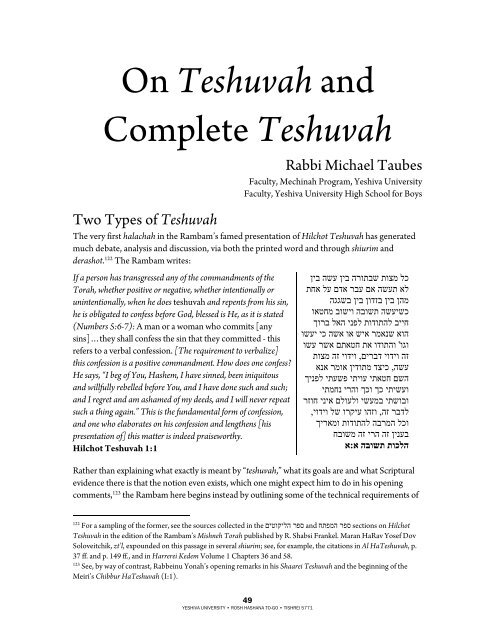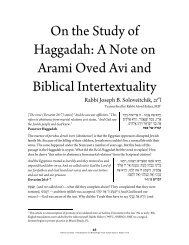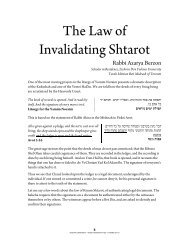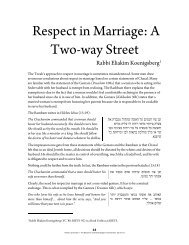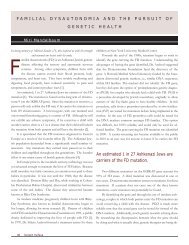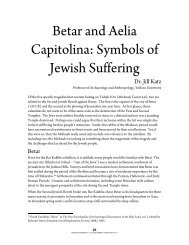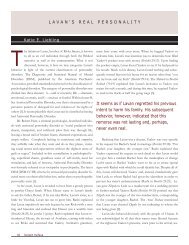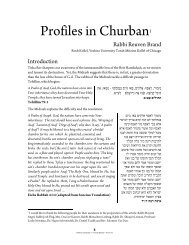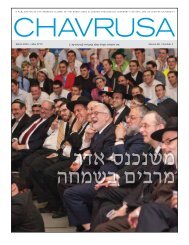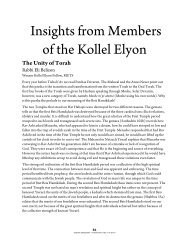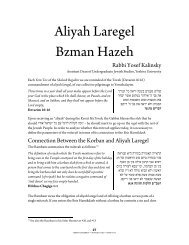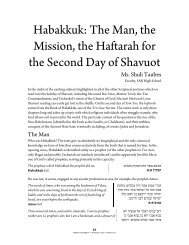YESHIVA UNIVERSITY • ROSH HASHANA TO-GO ... - YUTorah.org
YESHIVA UNIVERSITY • ROSH HASHANA TO-GO ... - YUTorah.org
YESHIVA UNIVERSITY • ROSH HASHANA TO-GO ... - YUTorah.org
You also want an ePaper? Increase the reach of your titles
YUMPU automatically turns print PDFs into web optimized ePapers that Google loves.
On Teshuvah and<br />
Complete Teshuvah<br />
Rabbi Michael Taubes<br />
Faculty, Mechinah Program, Yeshiva University<br />
Faculty, Yeshiva University High School for Boys<br />
Two Types of Teshuvah<br />
The very first halachah in the Rambam’s famed presentation of Hilchot Teshuvah has generated<br />
much debate, analysis and discussion, via both the printed word and through shiurim and<br />
derashot. 122 The Rambam writes:<br />
If a person has transgressed any of the commandments of the<br />
Torah, whether positive or negative, whether intentionally or<br />
unintentionally, when he does teshuvah and repents from his sin,<br />
he is obligated to confess before God, blessed is He, as it is stated<br />
(Numbers 5:6-7): A man or a woman who commits [any<br />
sins]…they shall confess the sin that they committed - this<br />
refers to a verbal confession. [The requirement to verbalize]<br />
this confession is a positive commandment. How does one confess?<br />
He says, “I beg of You, Hashem, I have sinned, been iniquitous<br />
and willfully rebelled before You, and I have done such and such;<br />
and I regret and am ashamed of my deeds, and I will never repeat<br />
such a thing again.” This is the fundamental form of confession,<br />
and one who elaborates on his confession and lengthens [his<br />
presentation of] this matter is indeed praiseworthy.<br />
Hilchot Teshuvah 1:1<br />
49<br />
<strong>YESHIVA</strong> <strong>UNIVERSITY</strong> <strong>•</strong> <strong>ROSH</strong> <strong>HASHANA</strong> <strong>TO</strong>-<strong>GO</strong> <strong>•</strong> TISHREI 5771<br />
ןיב השע ןיב הרותבש תוצמ לכ<br />
תחא לע םדא רבע םא השעת אל<br />
הגגשב ןיב ןודזב ןיב ןהמ<br />
ואטחמ בושיו הבושת השעישכ<br />
ךורב לאה ינפל תודותהל בייח<br />
ושעי יכ השא וא שיא רמאנש אוה<br />
ושע רשא םתאטח תא ודותהו 'וגו<br />
תוצמ הז יודיו , םירבד יודיו הז<br />
אנא רמוא ןידותמ דציכ , השע<br />
ךינפל יתעשפ יתיוע<br />
יתאטח םשה<br />
יתמחנ ירהו ךכו ךכ יתישעו<br />
רזוח יניא םלועלו ישעמב יתשובו<br />
, יודיו לש ורקיע והזו , הז רבדל<br />
ךיראמו תודותהל הברמה לכו<br />
חבושמ הז ירה הז ןינעב<br />
א:<br />
א הבושת תוכלה<br />
Rather than explaining what exactly is meant by “teshuvah,” what its goals are and what Scriptural<br />
evidence there is that the notion even exists, which one might expect him to do in his opening<br />
comments, 123 the Rambam here begins instead by outlining some of the technical requirements of<br />
122 For a sampling of the former, see the sources collected in the םיטוקילה רפס and חתפמה רפס sections on Hilchot<br />
Teshuvah in the edition of the Rambam’s Mishneh Torah published by R. Shabsi Frankel. Maran HaRav Yosef Dov<br />
Soloveitchik, zt’l, expounded on this passage in several shiurim; see, for example, the citations in Al HaTeshuvah, p.<br />
37 ff. and p. 149 ff., and in Harrerei Kedem Volume 1 Chapters 36 and 58.<br />
123 See, by way of contrast, Rabbeinu Yonah’s opening remarks in his Shaarei Teshuvah and the beginning of the<br />
Meiri’s Chibbur HaTeshuvah (I:1).


